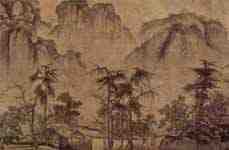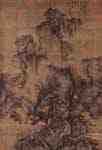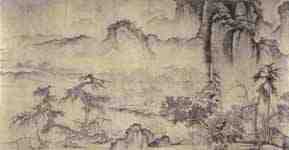Kuo Hsi
Paintings


Drawings

Guo Xi (Chinese: 郭熙; pinyin: Guō Xī; Wade–Giles: Kuo Hsi) (c. 1020 – c. 1090)[1] Chinese landscape painter from Henan Province[2] who lived during the Northern Song dynasty. One text entitled "The Lofty Message of Forest and Streams" (Linquan Gaozhi 林泉高致) is attributed to him. The work covers a variety of themes centered on the appropriate way of painting a landscape. He was a court professional, a literatus, well-educated painter who developed an incredibly detailed system of idiomatic brushstrokes which became important for later painters. One of his most famous works is Early Spring, dated 1072. The work demonstrates his innovative techniques for producing multiple perspectives which he called "the angle of totality." This type of visual representation is also called "Floating Perspective," a technique which displaces the static eye of the viewer and highlights the differences between Chinese and Western modes of spatial representation.
The following is an excerpt from his treatise, "mountains and waters":
The clouds and the vapours of real landscapes are not the same at the four seasons. In spring they are light and diffused, in summer rich and dense, in autumn scattered and thin, in winter dark and solitary. When such effects can be seen in pictures, the clouds and vapours have an air of life. The mist around the mountains is not the same at the four seasons. The mountains in spring are light and seductive as if smiling: the mountains in summer have a blue-green colour which seems to be spread over them; the mountains in autumn are bright and tidy as if freshly painted; the mountains in winter are sad and tranquil as if sleeping.[3]
Guo Xi was often referred to as a “Northern Song master” when it came to painting. His work inspired many later artists and he even had landscapes dedicated to him. His lesser-known “Deep Valley” scroll painting depicts a serene mountain valley covered with snow and several trees struggling to survive on precipitous cliffs. The ink washes and amorphous brush strokes are employed to model surfaces that suggest the veiling effects of the atmosphere. One of Guo Xi’s techniques was to layer ink washes to build up forms and his “Deep Valley” is a masterpiece of the use of light ink and magnificent composition.[4]
See also
Culture of the Song Dynasty
Chinese painting
Chinese art
History of Chinese art
References
Barnhart: Page 372. Guo Xi's style name was Chunfu (淳夫)
Ci hai: Page 452
The Rise and splendour of the chinese empire, rene grousset, p. 195
Hearn, Maxwell K. Cultivated Landscapes: Chinese Paintings from the Collection of Marie-Hélène and Guy Weill. New York: The Metropolitan Museum of Art, Yale University Press, 2002.
Barnhart, R. M. et al. (1997). Three thousand years of Chinese painting. New Haven, Yale University Press. ISBN 0-300-07013-6
Ci hai bian ji wei yuan hui (辞海编辑委员会). Ci hai (辞海). Shanghai: Shanghai ci shu chu ban she (上海辞书出版社), 1979.
Guo Xi's Early Spring
---
Fine Art Prints | Greeting Cards | Phone Cases | Lifestyle | Face Masks | Men's , Women' Apparel | Home Decor | jigsaw puzzles | Notebooks | Tapestries | ...
---
Artist
A - B - C - D - E - F - G - H - I - J - K - L - M -
N - O - P - Q - R - S - T - U - V - W - X - Y - Z
Retrieved from "http://en.wikipedia.org/"
All text is available under the terms of the GNU Free Documentation License


